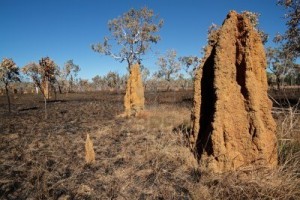The World’s Oldest Gold Prospecting Tools: Termites and Ants?


Giant termite mounds in Australia.
Some companies that want to find gold in Australia are starting to look at termite mounds as sources of information about whether or not large deposits of gold underneath the ground.
According to this article from Australasian Mining, geologists and entomologists are starting to use termites, ants and other insects to find gold deposits that are too deep in the ground to detect by other technological methods. Apparently the termites, which can burrow many meters beneath the ground, bring up tiny particles of gold that eventually amasses in the termite mounds. Scientists are discovering that the gold concentration in the mounds can be a good indicator of what lies beneath, as well.
Australia isn’t the first place that termite mounds have been used to prospect for gold deposits. In fact, civilizations in Africa have been using termites and ant mounds to prospect for gold deposits for hundreds of years. Because they drill down so far into the ground in search of water, termites can often reach depths that humans cannot . . . and they sometimes bring back particles of the material that they dig through, including gold.
And gold isn’t the only valuable mineral that has been discovered using termite mounds. Copper, nickel and even diamond mines have been discovered by checking out termite mounds, too.
In addition to gold particles present in the mounds, gold can also be detected in the termites themselves if there is a high concentration of the valuable metal in the vicinity. Apparently metals like gold can build up in the digestive systems of insects, and show up as tiny kidney stone-like lumps.
In addition to testing termite and ant mounds for gold concentrations, civilizations have also been checking plants for gold traces for hundreds of years.
So before you think that gold panning, metal detecting and drilling are the only methods available to us to prospect for gold deposits, think again. Nature has been providing human beings with gold deposit indicators for many centuries!

